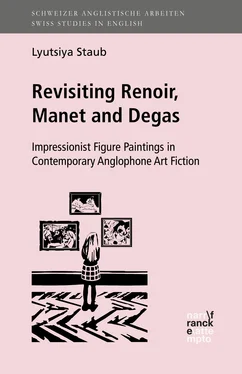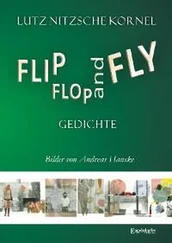The earliest definition of ekphrasis is found in the field of classical rhetoric, and appears in a late classical Greek collection of rhetorical handbooks, called Progymnasmata .4 It is given as “a speech that brings the subject matter vividly before the eyes.”5 The effect of vividness, or enargeia , is seen as a defining quality of ekphrasis and, therefore, as central to its understanding. Enargeia is an “impact on the mind’s eye of the listener who must […] be almost made to see the subject” (Webb, “Ekphrasis Ancient and Modern” 13). In antiquity, ekphrasis was studied to be used as a rhetorical technique (28), as a means of “achieving persuasion [and] altering the listener’s perception of the subject in a way that helped the orator to win their assent” (10). The subjects of ekphrasis (as presented in Progymnasmata ) range from descriptions of persons, mute animals, plants, places, events, festivals, times, seasons, states of affairs and the manner in which something is done to descriptions of paintings and statues (56). Hagstrum points out that “[t]he skill to create set descriptions, intended to bring visual reality before the mind’s eye by means of words […] was an admired and fully approved trick of the rhetorician’s trade and as such was a regular scholastic exercise” (29). Therefore, the ultimate goal of ekphrasis as a rhetorical device lies in rendering any given subject into words and delivering it in such a way as to transform the listener into a viewer. Consequently, the referent recedes into the background, being less important than the optimal effect of enargeia produced on the listener:
Enargeia implies the achievement in verbal discourse of a natural quality or of a pictorial quality that is highly natural. Enargeia refers to the actualization of potency, the realization of capacity or capability, the achievement in art and rhetoric of the dynamic and purposive life of nature. (33)
However, when ekphrasis is applied to the field of literary studies, the subject matter draws special attention from scholars, and it is subject to restrictions that are outlined in this chapter. These restrictions are registered in the Oxford Classical Dictionary. In its first (1949) and second (1970) editions, ekphrasis is defined as “the rhetorical description of a work of art, one of the types of progymnasma (rhetorical exercise, q.v.)” (Hammond 377). In the third (1996) and the fourth (2012) editions, it is interpreted as “an extended and detailed literary description of any object, real or imaginary” (Hornblower 495). The difference between ekphrasis as a rhetorical device and ekphrasis as a literary device has been studied by Goehr, who argues that:
Whereas modern ekphrasis, especially from the late nineteenth century on, focuses on artworks and their mediums, ancient ekphrasis focused on speech and written acts performed within a wide range of practices necessary for the education of citizens. Modern ekphrasis focuses on works that bring other works to aesthetic presence; ancient ekphrasis focused on speech acts that brought objects, scenes, or events to imaginary presence. (397)
In other words, the essential difference between the late classical definition and the modern understanding of ekphrasis is that ekphrasis is no longer characterised by an effect on the listener and the metamorphosis of listener into viewer, but rather by its reference to an artefact, more specifically, an artwork.
One of the earliest definitions of ekphrasis as a literary device is provided by Saintsbury in 1908, who interprets it as “a set description intended to bring person, place, picture, etc., vividly before the mind’s eye” (491). By and large, Saintsbury’s interpretation resembles the understanding of ekphrasis as a rhetorical device that aims to make the reader envision a given subject; not only is the subject matter not clearly defined, but the pictorial source – if that is what is meant by “picture” – is not separated from any other object that can be described verbally. In 1955 Spitzer makes ekphrasis more specific by giving it a more restricted definition: “the poetic description of a pictorial or sculptural work of art, whose description implies […] ‘une transposition d’art’, the reproduction, through the medium of words, of sensuously perceptible objets d’art” (218). Krieger delimits the subject matter as “a pictorial or sculptural work of art”, yet at the same time he limits ekphrasis, claiming that it pertains to only one form of literature. Spitzer’s interpretation is later commented on by Krieger, who says that “[e]kphrasis, according to this definition, clearly presupposes that one art, poetry, is defining its mission through its dependence on the mission of another art – painting, sculpture, or others” ( Ekphrasis: The Illusion of the Natural Sign 6). Initially, Krieger (1967) interprets ekphrasis as “the imitation in literature of a work of plastic art” (“ Ekphrasis and the Still Movement of Poetry” 265), thus emphasising the importance of ekphrasis as going beyond only poetry and, later on, insisting on extending “the range of possible ekphrastic objects by re-connecting ekphrasis to all ‘word-painting’” ( Ekphrasis: The Illusion of the Natural Sign 9). Krieger’s definition is later rephrased by Piltz and Åström, who claim that “ekphrasis is a descriptive discourse that clearly brings before our eyes the things, persons or actions depicted […] [it] is a word-picture” (50). However, Krieger develops his original definition, becoming more explicit about what is meant by plastic art: “I use ekphrasis (as it has commonly been used for some time), to refer to the attempted imitation in words of an object of the plastic arts, primarily painting or sculpture” ( Ekphrasis: The Illusion of the Natural Sign 4). A further interpretation is suggested by Bender, who refers to ekphrasis as a “literary description of real or imagined works of visual art” (51). By the same token, Kurman identifies ekphrasis as “the description in verse of an art object” (1); Weisstein correspondingly interprets it as “literary works describing specific works of art” (23), while Howatson states that ekphrasis is a “type of rhetorical exercise taking the form of a description of a work of art” (203).
Description, une transposition d’art , reproduction, imitation and descriptive discourse – these are the words that are used frequently to define ekphrasis. The scholars quoted above emphasise description as the main function of ekphrasis, agreeing that an ekphrastic text contains a description of an artwork (physically existing or fictitious) that is reproduced or imitated through the medium of words. However, understanding ekphrasis as having a merely descriptive function is rather limited and misleading as it ignores the interpretative potential of ekphrasis, which in turn suggests another way of perceiving an artwork via a literary text. The art historian David Carrier tries to draw a distinction between ekphrastic description and interpretation:
An ekphrasis tells the story represented, only incidentally describing pictorial composition. An interpretation gives a systematic analysis of composition. Ekphrases are not concerned with visual precedents. Interpretations explain how inherited schema [sic] are modified. An ekphrasis only selectively indicates details; an interpretation attends to seemingly small points, which may, indeed, change how we see the picture as a whole when they are analysed. An interpretation treats the picture as an image, and so tells both what is represented and how it is represented. (21)
Although he admits that ekphrasis incidentally refers to details of pictorial composition, he does not believe that ekphrastic description of carefully selected details can create and/or influence the interpretation of an artwork. In other words, and similarly to many other scholars, Carrier separates ekphrastic texts from Bildgedicht texts (Kranz).6 This distinction may sound plausible in theory; however, it fails to function in practice due to the simple fact that the act of describing involves an inherently interpretative function. Description becomes a means of representing an artwork and it is affected by many factors, including the subjective opinion of the viewer, the general understanding of the composition of an artwork, the ability to relate to the period of its creation and interpret the encoded meanings. The attempt to represent verbally what is represented in a pictorial source, without knowing the original intention of the artist, leads to the creation of new meanings and therefore new interpretations of the artwork. As such, it may affect the way it is perceived by others. In Oscar Wilde’s essay “The Critic as Artist”, one of the characters, Gilbert, discusses assigning new meanings to a painting and suggests the following:
Читать дальше












